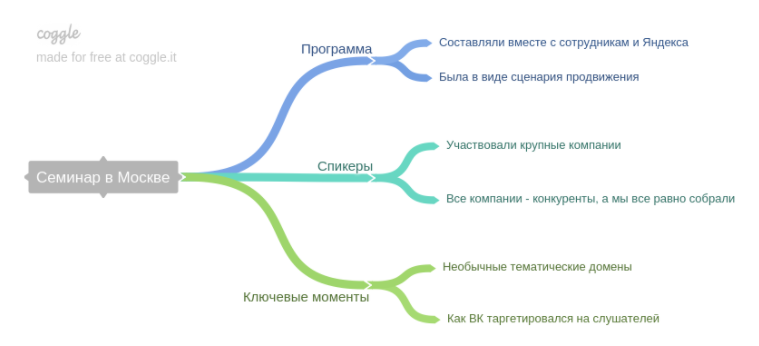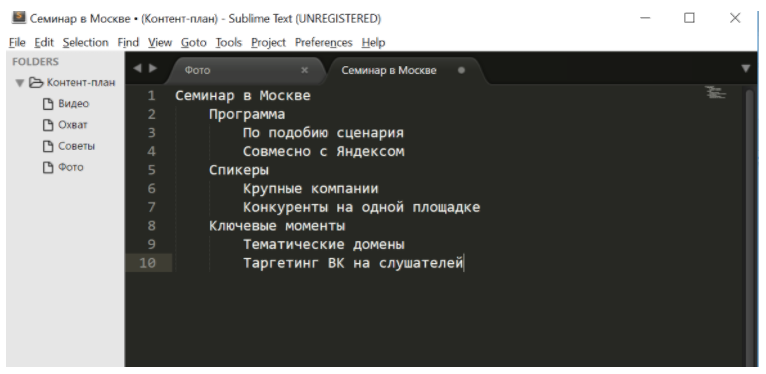How to write when you do not know how lazy
Many people compare writing with some kind of creative process. This is a mistake - we all can write by default. At first we were taught writing in school, and then messengers came, and this business turned into a daily habit.
But we say more often than we write. That is why, when you need to write an explanatory letter or article, it becomes lazy and I want to explain everything verbally. In order not to be lazy, we need a systematic approach and a little patience. In this article I will talk about the algorithm that helps me write.
The first thing you need to put in order is a bunch of information in your head.
It is best to plan according to the principle of the tree. Its essence is that in the story you go from the general to the particular. The main idea of the letter is a tree trunk. The resulting details are branches. Background information - leaves.
')
For example, we want to tell about the past event. The event is the trunk. The branches will be speakers. Leaflets - information about each speaker, presentation and key points.
Sasha Karepina writes in more detail about the principle of wood and other letters in the book The Art of Business Writing .

In terms of, go from the general to the particular: first the main thought - then the details
At this stage it is not necessary to bother, how to paint all this then. You should have only a structure. And the plan can not just be remembered. Be sure to write it in a notebook. You can draw on paper or paint directly in the editor.

The main thing is that the plan should be in front of the eyes, and not in the head. You can type it directly in the editor.
When the plan is not in the head, but before the eyes, it becomes clear what section is in place and what needs to be moved. You can even write each item on the cards and move them as needed. Cards with extra information that leads away from the main idea can be safely thrown away. And similar cards - to group.
Sketch is a raw text version. In the sketch may be errors and tonality of the shoemaker. You simply take an item from your plan and paint it in your own words.
At the beginning there is a risk of sticking to a blank screen and choosing the first word for a long time. This is called “white sheet syndrome”.
To overcome the syndrome, start with the words “Hello, dear ...” and then the name of the person you know. It can be a friend, sister, dad or grandmother. Ideal if this person fits the description of your future readers.
About how to start and, in general, about the letter I advise two more books:
Another plus of this method is that you are telling a story to a real person, and not to an abstract crowd of readers. That's right: although you write for a wide audience, a person usually reads alone.
When writing a sketch, do not worry about how the text sounds. Perhaps later it will change radically. Now you need the way your voice dictates: with a tautology and unrelated paragraphs.
The text can be compared with the statue, where the author is a sculptor. In the first step, we built the frame of our statue. In the second, fatty smears were thrown and got a rough shape. Now we will hone the silhouette and grind irregularities.
Written sketch needs to be edited. There are many inconsistencies, tautologies, curved structures and redundant information. The best way to fix this is to read the text out loud. Loud to hear yourself.
Ridiculous constructions are found in the text, because we do not write as we speak. When reading the text out loud, you understand where the reader may stumble. Such fragments need to be rephrased and checked again. Do not be afraid to rewrite entire sentences and paragraphs - the result will impress you.
And so with all the text: corrected the sentence - read out loud. It is necessary to read easily and naturally. Easy means in one breath and without pauses. Naturally - as in colloquial speech.
Common mistakes I encounter during the editing phase:
Repetitions . When the same word is used in several sentences in a row. To avoid repetitions, choose a synonym. If not, rewrite the whole sentence.
When you are busy with text for a long time, it is difficult to soberly evaluate it. In the people speak "the eye was zamililsya". It happens with a short message, and with a large article. To return a sober look, you need to distract. You can drink tea, take a walk, chat with a colleague. Just forget about the text and do something else.
If the deadlines are not tight, it is better to postpone the final version the next day. Even in the army they say that a soldier should sleep with his letter. This is very wise advice - the next day you look at your article objectively and with a fresh head.
Before sending, be sure to check the text in special services. You may not notice a typo or spelling error, and the reader will take it all for illiteracy.
Speller - spelling errors
Glavred - complex designs and stamps
Orthograms - Commas and Typos
But we say more often than we write. That is why, when you need to write an explanatory letter or article, it becomes lazy and I want to explain everything verbally. In order not to be lazy, we need a systematic approach and a little patience. In this article I will talk about the algorithm that helps me write.
1. Make a plan
The first thing you need to put in order is a bunch of information in your head.
It is best to plan according to the principle of the tree. Its essence is that in the story you go from the general to the particular. The main idea of the letter is a tree trunk. The resulting details are branches. Background information - leaves.
')
For example, we want to tell about the past event. The event is the trunk. The branches will be speakers. Leaflets - information about each speaker, presentation and key points.
Sasha Karepina writes in more detail about the principle of wood and other letters in the book The Art of Business Writing .

In terms of, go from the general to the particular: first the main thought - then the details
At this stage it is not necessary to bother, how to paint all this then. You should have only a structure. And the plan can not just be remembered. Be sure to write it in a notebook. You can draw on paper or paint directly in the editor.

The main thing is that the plan should be in front of the eyes, and not in the head. You can type it directly in the editor.
When the plan is not in the head, but before the eyes, it becomes clear what section is in place and what needs to be moved. You can even write each item on the cards and move them as needed. Cards with extra information that leads away from the main idea can be safely thrown away. And similar cards - to group.
2. Sketch a sketch
Sketch is a raw text version. In the sketch may be errors and tonality of the shoemaker. You simply take an item from your plan and paint it in your own words.
At the beginning there is a risk of sticking to a blank screen and choosing the first word for a long time. This is called “white sheet syndrome”.
To overcome the syndrome, start with the words “Hello, dear ...” and then the name of the person you know. It can be a friend, sister, dad or grandmother. Ideal if this person fits the description of your future readers.
About how to start and, in general, about the letter I advise two more books:
- “Writing is easy,” Olga Solomatina
- "Author, scissors paper" , Nikolay Kononov
Another plus of this method is that you are telling a story to a real person, and not to an abstract crowd of readers. That's right: although you write for a wide audience, a person usually reads alone.
When writing a sketch, do not worry about how the text sounds. Perhaps later it will change radically. Now you need the way your voice dictates: with a tautology and unrelated paragraphs.
3. Read aloud and edit
The text can be compared with the statue, where the author is a sculptor. In the first step, we built the frame of our statue. In the second, fatty smears were thrown and got a rough shape. Now we will hone the silhouette and grind irregularities.
Written sketch needs to be edited. There are many inconsistencies, tautologies, curved structures and redundant information. The best way to fix this is to read the text out loud. Loud to hear yourself.
Ridiculous constructions are found in the text, because we do not write as we speak. When reading the text out loud, you understand where the reader may stumble. Such fragments need to be rephrased and checked again. Do not be afraid to rewrite entire sentences and paragraphs - the result will impress you.
And so with all the text: corrected the sentence - read out loud. It is necessary to read easily and naturally. Easy means in one breath and without pauses. Naturally - as in colloquial speech.
Common mistakes I encounter during the editing phase:
Repetitions . When the same word is used in several sentences in a row. To avoid repetitions, choose a synonym. If not, rewrite the whole sentence.
Poorly:Excess pronouns . As in the previous case, but instead of ordinary words - pronouns. Most of them can simply be deleted without losing meaning.
I often use classics quotes in my articles. Such quotes make a variety of work and, moreover, look solid.
Good:
I often use classics quotes in my articles. Such a move introduces a variety of work and, moreover, looks solid.
Poorly:Not the natural word order . Correcting a mistake is easy, just listen to your internal sense.
Once we ordered logos from freelancers. We have painted our project in detail and indicated the cost.
Good:
Once we ordered logos from freelancers - we painted the project in detail and indicated the cost.
Poorly:
I ordered a couple, so I can breed at home later.
Good:
I ordered a couple, then to breed at home.
4. Drink tea and read again.
When you are busy with text for a long time, it is difficult to soberly evaluate it. In the people speak "the eye was zamililsya". It happens with a short message, and with a large article. To return a sober look, you need to distract. You can drink tea, take a walk, chat with a colleague. Just forget about the text and do something else.
If the deadlines are not tight, it is better to postpone the final version the next day. Even in the army they say that a soldier should sleep with his letter. This is very wise advice - the next day you look at your article objectively and with a fresh head.
Before sending, be sure to check the text in special services. You may not notice a typo or spelling error, and the reader will take it all for illiteracy.
Speller - spelling errors
Glavred - complex designs and stamps
Orthograms - Commas and Typos
Source: https://habr.com/ru/post/336660/
All Articles